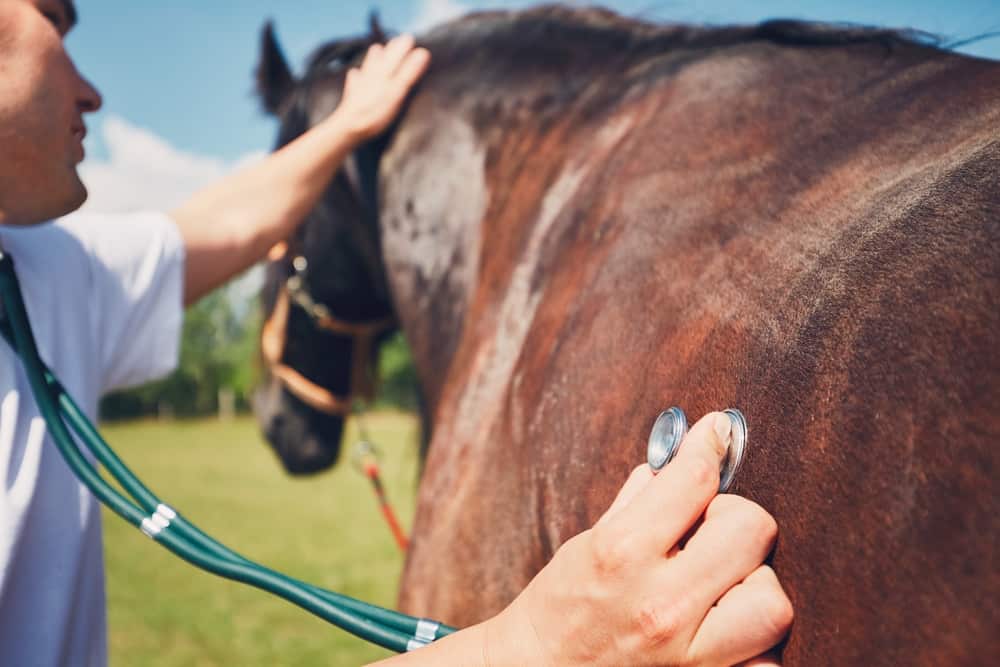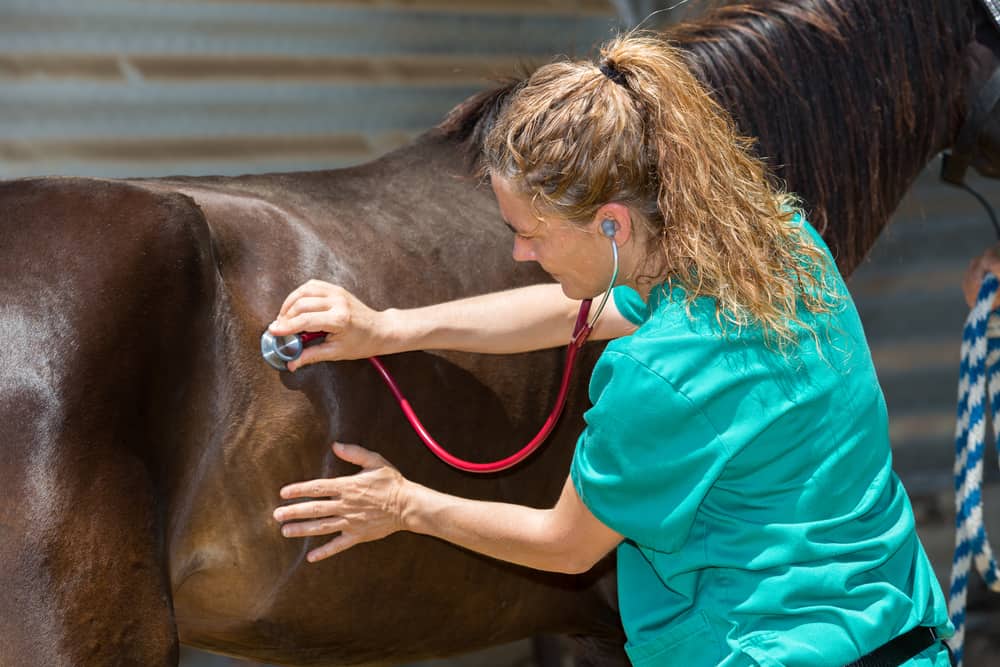- Your source for stall mats, rubber arena footing, arena harrows and arena dust control.

Cushing disease is one of the horse diseases and ailments that can affect your horse’s health and wellbeing. To understand if you can ride a horse with Cushing’s disease, we must look more closely at this syndrome and its causes. Is it safe to ride a horse with Cushing’s disease?
that can affect your horse’s health and wellbeing. To understand if you can ride a horse with Cushing’s disease, we must look more closely at this syndrome and its causes. Is it safe to ride a horse with Cushing’s disease?
You can ride a horse with Cushing’s disease of sound health if they are not suffering from laminitis and are on the correct medication. However, it is wise to consider a few things before riding a horse with Cushings, and to check with your veterinarian first, as each case is different.
Cushing’s disease is complicated and severe; to understand it, let’s find out more about it.
What is Cushing’s disease?
Equine Cushings disease, also known as Pars Pituitary Intermedia Dysfunction (PPID), is a disorder of a horses’ endocrine system (hormonal system). Equine Cushing’s disease is the enlargement of the middle section of the pituitary gland.
The pituitary gland location is in the base of the brain, and it is a vital endocrine organ that produces a variety of hormones. This gland controls the nervous system, making the chemical messengers (hormones) affect other parts of the body.
The enlargement of the pars intermedia results in the increased release of several hormones. The hormone ACTH or adrenocorticotropic hormone causes the adrenal glands near the kidneys to increase cortisol production, a type of steroid—this over-production of cortisol cause most of the clinical signs we see in a Cushings disease horse.
Horses diagnosed with Cushings disease have a diminished capacity to receive and send the dopamine signal due to neurodegeneration (decaying of nerves).
When the gland continues to grow unchecked, it just keeps excreting too many hormones. This excess of hormones confuses the body.
When the anterior pituitary is left to run wild in the absence of adequate dopamine, several physiological changes occur.
For example, too much beta-endorphin causes the horse to become tired and lethargic. Alpha-MSH contributes to the horse’s obesity and excessive hair growth, while ACHT causes excess levels of cortisol circulating.
Cortisol puts stress on the liver to produce sugar, which results in high blood sugar levels. It also suppresses the production of red and white blood cells, resulting in anemia, a lack of red blood cells, and leukopenia, a lack of white blood cells.
Red blood cells carry oxygen throughout the body, and white blood cells are the body’s defenders. Without enough of both, the horse becomes immune suppressed. Wounds won’t heal as fast, and infections are more likely.
The high blood sugar levels and all that cortisol circulating in the blood have a deleterious effect on the feet’ laminae, which predisposes the horse to crippling laminitis.
When the pituitary gland grows sufficiently in size pressing on other areas in the brain, it can result in seizures and blindness. In severe cases, Cushings can cause neurological disease.
Clinical signs of Cushings disease
Let’s look at some of the clinical signs of Cushings disease.
- Abnormal hair growth, long shaggy hair, and coat may be signs of advanced Cushing’s disease.
- Another sign is bouts of recurrent and often unexplained laminitis.
- Compromised immune system
- Potbellied appearance
- Ravenous appetite
- Increased urination
- Increased drinking
- Lethargy
- Recurrent skin infections
- Abnormal fat deposits above eyes and a pot belly
- Respiratory infections
- Dental disease
- Increased susceptibility to worms
- Muscle wasting
- Difficulty in controlling body temperature/abnormal sweating
- Reduced fertility in mares
How is Cushings disease diagnosed?
First identified some 70 years ago, it most commonly affects older horses and ponies over the age of 15 years. There are two tests recommended for horses with the clinical signs associated with Cushings disease.
We can diagnose the disease by doing a blood test to measure adrenocorticotropic hormone levels (ACTH) in horses with Cushings disease.
The Thyrotropin-releasing hormone test (TRH). This test involves giving TRH intravenously and assessing the levels and response of ACTH. When the ACTH levels are high, the diagnosis is Cushings disease.

How to manage and treat Cushings disease
There is no cure for Cushings disease. However, some drugs can help reduce the disease’s effects and improve your horse’s quality and longevity of life.
Pergolide is the most commonly used drug as a treatment. Pergolide is a dopamine agonist and has success rates of up to 80%, reducing the overall severity of signs seen in Cushingoid horses.
Pergolide comes in tablet form and can easily be crushed and added to feed. Pergolide has some side effects like loss of appetite, lethargy, diarrhea, and colic. Your veterinarian will advise that the lowest dose at first. Horses treated with Pergolide will remain on it for life.
Management is just as important as medication. Frequent inspections for wounds and signs of infection are essential. Prompt veterinarian treatment is vital as affected horses have reduced immunity levels and need intensive and prolonged treatment than other horses.
Regular farrier visits and dental treatment, and annual vaccinations are vital. Horses with Cushings need more aggressive worm control measures as horses and ponies who have Cushings showed higher worm egg counts than their standard counterparts.
A low carbohydrate/high-fat diet can help reduce the effects of muscle loss. Giving a protein supplement safe for metabolic horses can help boost energy levels. Additional antioxidants like Vitamin C can also be beneficial.
A Cushing diseased horse’s life expectancy can be reduced by 5 to 8 years due to the disease.
Considerations when riding a horse with Cushings
- Laminitis is extremely painful and recurrent in Cushing’s horses. If it has foundered, you may ride your horse if he is comfortable on his feet.
- Vision, some horses with advanced Cushing’s disease can develop blindness due to the pituitary’s impingement on the optic nerves. You should contact your veterinarian if there is any doubt of your horse’s vision status.
- Overheating, due to the excessive hair growth related to Cushing’s disease, horses can overheat quickly. You should give your horse a full-body clip to help him stay cool.
- Keep an eye on your horse’s energy levels and his general soundness before consider riding him. Some horses take longer to recover after a bout of laminitis or infection and might need a longer recovery time before put into any exercise routine.
Structured riding exercise routine
Many horses with Cushing’s disease will benefit from a lightly structured exercise routine. Veterinarians highly recommend light exercise to help reduce your horse’s weight and assist his metabolism.
However, you should always tailor activity and exercise to each horse’s ability and soundness. Healthy horses diagnosed with Cushing’s disease doing well with medication can continue a regular exercise routine.
Cushing’s horses with a history of laminitis should only gradually return to exercise under a veterinarian’s direction. Laminitis can be extremely painful.
There are specific guidelines for the duration, level, and intensity of workouts for Cushing’s horses. Most owners know their horses very well, so keep a close eye on your horse. If your horse is not as athletic or sound as he should be, you may take your horse out for a walk on the lead. If you are unsure of your horse’s soundness, seek your veterinarian’s advice and do not ride him.
Nutrition and diet of the Cushings horse
Managing your horse’s immune system is one of the most significant and beneficial measures you can take. The nutrition and diet of your horse are vital to its health. Provide a diet high in vitamins, minerals, and antioxidants. Horses with Cushing’s disease are more prone to insulin resistance and high blood sugar. Feed with high non-structural carbohydrates should be avoided.
Horses with Cushing’s require a low carb, highly digestible, high-energy feed. In most cases, with bad teeth, this will be in the form of a pelleted meal.
Some tips for feeding your horse with Cushings
- Avoid feeds that are high in cereals. Choose fiber-based, low sugar, and low starch feeds.
- Feed often and little at a time, less than 2 kg per meal is ideal.
- Feed a balanced diet full of protein, vitamins, and minerals.
- Analise your forage for water-soluble carbohydrates. It should be less than 10%
- Soak the hay for 12-16 hours (not more than 6 hours in warm weather). Soaking will reduce water-soluble carbohydrates up to 50%.
- Use a nutritional supplement to support the immune system.
- Make changes to your horse’s diet slowly.
Conclusion
While there is no cure for Cushing’s disease, it doesn’t mean the end for your horse and why you shouldn’t be able to ride him. With appropriate medication and treatment, as well as careful management, many Cushing’s horses can live happy, healthy, active lives for many years. Yes, you can ride your horse if he is diagnosed with Cushing’s disease. However, keep a close eye on his overall health and soundness before you do decide to ride him.
The key is to stay in touch with your veterinarian to ensure your horse’s condition is under control and that your horse is on the correctly prescribed medication. If there is any deterioration in your horse’s soundness when you start to ride your horse, it is better to stop immediately and contact your veterinarian.

